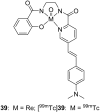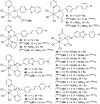Recent progress in the development of metal complexes as β-amyloid imaging probes in the brain
- PMID: 30108850
- PMCID: PMC6072098
- DOI: 10.1039/c7md00064b
Recent progress in the development of metal complexes as β-amyloid imaging probes in the brain
Abstract
In this review, we have focused on the recent progress in metal complexes that are able to bind to β-amyloid (Aβ) species. We have discussed various radioactive complexes of 99mTc, 68Ga, 64Cu, 89Zr, and 111In, which were designed as Aβ imaging agents for positron emission tomography (PET) and single photon emission computed tomography (SPECT) imaging, non-radioactive Re and Ru complexes as Aβ sensors using luminescence methods, and Gd3+ complexes as contrast agents for magnetic resonance imaging (MRI).
Figures

















Similar articles
-
Remarkable Brain Penetration of Cyclopentadienyl M(CO)3+ (M = 99mTc, Re) Derivatives of Benzothiazole and Benzimidazole Paves the Way for Their Application as Diagnostic, with Single-Photon-Emission Computed Tomography (SPECT), and Therapeutic Agents for Alzheimer's Disease.J Med Chem. 2019 Mar 14;62(5):2638-2650. doi: 10.1021/acs.jmedchem.8b01949. Epub 2019 Feb 28. J Med Chem. 2019. PMID: 30768272
-
Novel Benzofurans with (99m)Tc Complexes as Probes for Imaging Cerebral β-Amyloid Plaques.ACS Med Chem Lett. 2010 Aug 2;1(8):443-7. doi: 10.1021/ml100140d. eCollection 2010 Nov 11. ACS Med Chem Lett. 2010. PMID: 24900230 Free PMC article.
-
Technetium-99m labeled pyridyl benzofuran derivatives as single photon emission computed tomography imaging probes for β-amyloid plaques in Alzheimer's brains.J Med Chem. 2012 Mar 8;55(5):2279-86. doi: 10.1021/jm201513c. Epub 2012 Feb 24. J Med Chem. 2012. PMID: 22364445
-
Compounds for imaging amyloid-β deposits in an Alzheimer's brain: a patent review.Expert Opin Ther Pat. 2015 Apr;25(4):413-23. doi: 10.1517/13543776.2015.1007953. Epub 2015 Mar 8. Expert Opin Ther Pat. 2015. PMID: 25746836 Review.
-
Metal-Based Complexes as Pharmaceuticals for Molecular Imaging of the Liver.Pharmaceuticals (Basel). 2019 Sep 16;12(3):137. doi: 10.3390/ph12030137. Pharmaceuticals (Basel). 2019. PMID: 31527492 Free PMC article. Review.
Cited by
-
Al18F-NODA Benzothiazole Derivatives as Imaging Agents for Cerebrovascular Amyloid in Cerebral Amyloid Angiopathy.ACS Omega. 2018 Oct 31;3(10):13089-13096. doi: 10.1021/acsomega.8b01120. Epub 2018 Oct 12. ACS Omega. 2018. PMID: 30411027 Free PMC article.
-
Recent Developments in Metal-Based Drugs and Chelating Agents for Neurodegenerative Diseases Treatments.Int J Mol Sci. 2019 Apr 12;20(8):1829. doi: 10.3390/ijms20081829. Int J Mol Sci. 2019. PMID: 31013856 Free PMC article. Review.
-
Design of a multivalent bifunctional chelator for diagnostic 64Cu PET imaging in Alzheimer's disease.Proc Natl Acad Sci U S A. 2020 Dec 8;117(49):30928-30933. doi: 10.1073/pnas.2014058117. Epub 2020 Nov 24. Proc Natl Acad Sci U S A. 2020. PMID: 33234563 Free PMC article.
-
Medicinal (Radio) Chemistry: Building Radiopharmaceuticals for the Future.Curr Med Chem. 2024;31(34):5481-5534. doi: 10.2174/0929867331666230818092634. Curr Med Chem. 2024. PMID: 37594105 Review.
-
Two-Photon Fluorescent Probes for Amyloid-β Plaques Imaging In Vivo.Molecules. 2023 Aug 22;28(17):6184. doi: 10.3390/molecules28176184. Molecules. 2023. PMID: 37687013 Free PMC article. Review.
References
-
- Nicoll J. A., Yamada M., Frackowiak J., Mazur-Kolecka B., Weller R. O., Neurobiol. Aging, 2004, 25 , 589 –597 , discussion 603-584 . - PubMed
Publication types
LinkOut - more resources
Full Text Sources
Other Literature Sources

